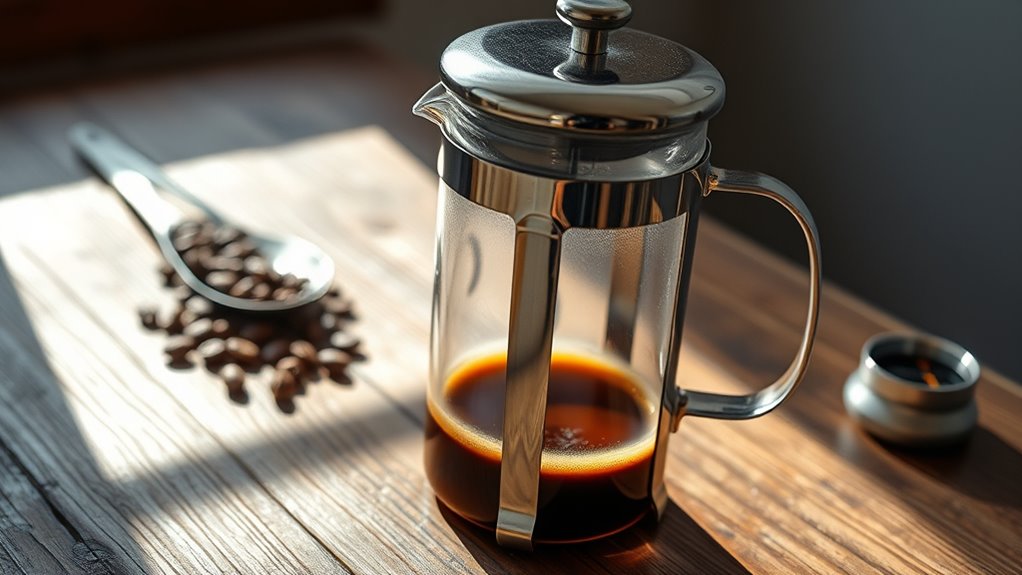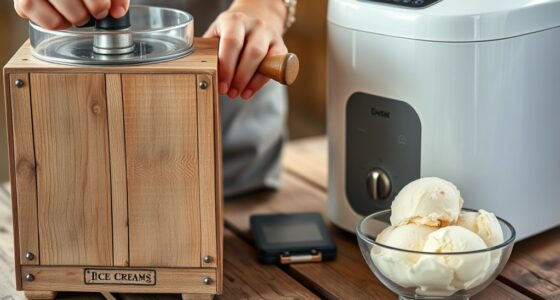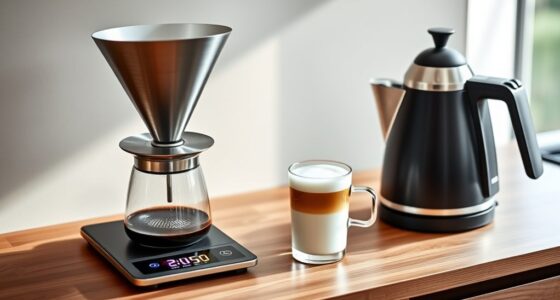A French press gives you rich, full-bodied coffee by keeping oils and flavor intact, and it allows full control over brewing time and temperature. However, it can leave sediment in your cup, and working manually might be a bit of a hassle. Plus, it’s less suited for large groups and may lose heat quickly if not insulated. Want to discover tips to maximize your brew and avoid common pitfalls? Keep exploring for more insights.
Key Takeaways
- French press produces rich, full-bodied coffee by retaining oils and antioxidants, with full control over brewing parameters.
- Common drawbacks include sediment at the bottom, heat loss in non-insulated models, and the manual effort required for pressing and cleaning.
- Use coarse grind, maintain water temperature between 195°F-205°F, and steep for about 4 minutes for optimal flavor.
- Preheat the press, clean immediately after brewing, and replace mesh filters annually to ensure consistent quality.
- Environmentally friendly and durable, French presses generate no waste and are suitable for travel, making them a sustainable brewing choice.

A French press is a popular brewing method that offers a simple and cost-effective way to make flavorful coffee. With models ranging from just $7.99 to over $129, it’s accessible to nearly everyone. One of its biggest advantages is the rich flavor it produces. Because it retains oils from the coffee beans without using paper filters, your brew will have a fuller, more robust taste.
This method also grants you full control over your coffee’s flavor profile. You can adjust brew time, water temperature, and grind size to suit your preferences. Plus, its portable design makes it ideal for travel or off-grid locations, so you can enjoy good coffee wherever you go. Additionally, many French presses are made from plastic-free materials, avoiding BPA and phthalate exposure, which appeals to health-conscious users.
However, there are some downsides to think about. Since it doesn’t use fine filtration, you might notice sediment at the bottom of your cup, which isn’t appealing to everyone. The manual process also requires effort—pressing the plunger and cleaning it afterward takes more time and physical effort than simply flipping a switch on an electric drip machine. Non-insulated models may struggle with heat retention, so your coffee might cool faster than desired.
Over-brewing is another concern; leaving the coffee in the press too long can lead to bitterness, so timing is vital. Capacity is limited compared to large drip carafes, which can make brewing for groups more challenging.
Using a French press also offers notable health benefits. The brewing process preserves antioxidants like methylpyridinium, which have cancer-fighting properties. It contains compounds such as chlorogenic acid lactones and lipophilic antioxidants that may protect your neurological health. Drinking coffee made this way could also lower the risk of certain cancers, including oral, pharyngeal, and esophageal cancers.
For those with liver issues, it might support health against hepatocellular carcinoma, especially in cirrhosis patients. Since it avoids paper filters, no chemicals from filter processing leach into your coffee, making it a cleaner option.
Environmentally, the French press shines because it produces zero disposable waste—no pods or filters to throw away. Its reusable parts reduce long-term waste, and it’s energy-efficient compared to electric brewers. Durability is a plus, as well-made models last a long time, minimizing replacements. Plus, the absence of chemicals involved in filter production means you’re not exposing yourself to bleach or other processing residues.
To get the best results, use a coarse grind to prevent sediment and over-extraction. Maintain water temperature between 195°F and 205°F for a balanced brew, and stick to a 4-minute steep time. Preheating your press helps maintain consistent temperature, and cleaning immediately after brewing prevents oil buildup. Being aware of the transformation that occurs during the brewing process can help you optimize flavor and health benefits.
Regularly disassemble and clean parts, replace mesh filters annually, and descale monthly with vinegar solutions to prolong your press’s life. Store it dry to prevent mold.
Avoid common mistakes like using fine grounds that clog the filter or stirring too vigorously, which can cause bitterness. Don’t pour boiling water directly onto the coffee, as it can scorch the oils, and avoid leaving the coffee in the press for too long after brewing to prevent over-extraction.
Also, stick to recommended coffee-to-water ratios, usually about 1:15, for the best flavor.
Frequently Asked Questions
How Long Should I Steep Coffee in a French Press?
You should steep your coffee in a French press for about 4 minutes, which is the standard time. If you prefer a richer flavor, extend it to 6 or even 8 minutes.
Factors like grind size and water temperature influence this timing. Use a timer, keep the water between 195°F and 205°F, and experiment to find the perfect steeping duration that matches your taste preferences.
Can I Use Ground Coffee of Any Size?
Using any coffee grind size is like trying to fit a square peg into a round hole — it just doesn’t work well. For your French press, you need a coarse grind, about the size of kosher salt, to prevent grounds from slipping through and to get the best flavor.
Finer grounds can cause sediment and bitterness, so stick to the right size for a smooth, rich brew.
Is French Press Coffee Suitable for Travel?
Yes, French press coffee is great for travel because it’s simple, portable, and doesn’t require electricity. You can easily pack a compact, durable model made of stainless steel, which keeps your coffee hot and resists damage.
Plus, it’s versatile for brewing both coffee and tea. Just pick a leak-proof, easy-to-clean design, and you’ll enjoy fresh, tasty drinks wherever your adventures take you.
How Do I Prevent Coffee Grounds From Escaping?
To prevent coffee grounds from escaping, start by using a coarser grind, ideally with a burr grinder, for consistent size.
When brewing, press the plunger slowly and steadily to avoid disturbing the grounds.
Verify the filter fits snugly and clean your press regularly to maintain its effectiveness.
After pressing, let the coffee sit briefly to allow grounds to settle, then pour carefully to minimize sediment.
What’S the Best Way to Clean a French Press?
To clean your French press effectively, start by rinsing it immediately with hot water after brewing to loosen grounds and oils.
Use a small amount of mild dish soap and a soft-bristled brush or nylon scrubber to scrub away stubborn residues.
Rinse thoroughly and dry it completely with a towel.
Following the manufacturer’s instructions guarantees you maintain your French press in great condition and prevent buildup.
Conclusion
Now that you know the pros and cons of using a French press, you can decide if it’s the right brew method for you. Did you know that over 60% of coffee enthusiasts prefer the French press for its rich flavor? With simple tips, you’ll enjoy a perfect cup every time. Whether you love boldness or smoothness, embracing this method can elevate your coffee game. Cheers to better mornings and bolder brews!









